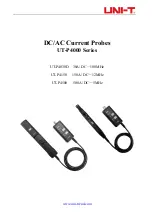
6
sound an alarm.
5)
Jaw on indicator
When the light is on, it means that the push rod is in the unlock state. Make sure that the jaw is in the lock
state during the measurement.
6)
Degaussing and Zero Setting Indicator
After pressing the degaussing zero button, the indicator light will be green, and after degaussing, the
indicator light will be off. If degaussing setting succeeds, the buzzer will make two short beeps. If
degaussing setting failed, the buzzer will make an extension beep of about one second.
7)
Range LED Indicator
The green LED indicates the selected range.
8)
Degauss auto zero button
Frequent usage of the device will generate residual magnetic field. Please degauss and zero set before
measurement for better measurement precision. Press the degaussing and auto zero button to trigger the
process (should be around 5s).
9)
Range selected button
Model
Range
Transfer ratio
UT-P4030D
30A
0.1V/A
5A
1V/A
UT-P4150
150A
0.01V/A
30A
0.1V/A
UT-P4500
500A
0.01V/A
75A
0.1V/A
10)
Power supply socket
External power supply socket, standard with (12V/1A) adapter.
3.
Making Measurements
Before using the probe, check that the system is safe and that the preparations described in Safe Probing.
Have a visual inspection of the current probe of high frequency UT-P4000 Series probes,
power supply, cable, and oscilloscope.
The output of the current probe is terminated internally. Use a high impedance input to the measuring
instrument. Be sure to set the input impedance to 1 MΩ before making measurements. Set the
oscilloscope’s input coupling to DC. With the oscilloscope input at ground, adjust the trace to the zero
position. Connect the probe’s output connector to the oscilloscope’s input connector.
Connect the power supply to probe and the power indicator will light. Select suitable Range you want
via the Range Key.
Ensure that the probe sensor is NOT clamped around any conductors. Slide the probe’s Opening Lever

















